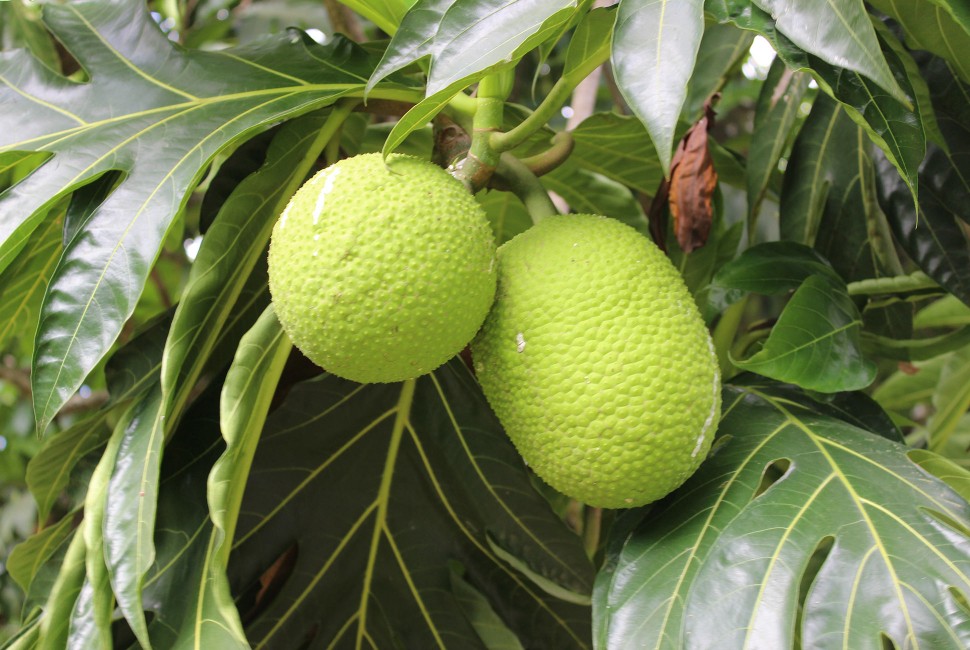In the face of climate change, breadfruit soon might come to a dinner plate near you.
While researchers predict that climate change will have an adverse effect on most staple crops, including rice, corn and soybeans, a new Northwestern University study finds that breadfruit — a starchy tree fruit native to the Pacific islands — will be relatively unaffected.
Because breadfruit is resilient to predicted climate change and particularly well-suited to growing in areas that experience high levels of food insecurity, the Northwestern team believes breadfruit could be part of the solution to the worsening global hunger crisis.
The study was published today (Aug. 17) in the journal PLOS Climate.
“Breadfruit is a neglected and underutilized species that happens to be relatively resilient in our climate change projections,” said Northwestern’s Daniel Horton, a senior author on the study. “This is good news because several other staples that we rely on are not so resilient. In really hot conditions, some of those staple crops struggle and yields decrease. As we implement strategies to adapt to climate change, breadfruit should be considered in food security adaptation strategies.”
Horton is an assistant professor of Earth and planetary sciences in Northwestern’s Weinberg College of Arts and Sciences, where he leads the Climate Change Research Group. Lucy Yang, a former student in Horton’s laboratory, is the paper’s first author. For this study, Horton and Yang collaborated with breadfruit expert Nyree Zerega, director of the Program in Plant Biology and Conservation, a partnership between Northwestern and the Chicago Botanic Garden.
“As we implement strategies to adapt to climate change, breadfruit should be considered in food security adaptation strategies.” — Climate scientist Daniel Horton
Despite having “fruit” in its name, breadfruit is starchy and seedless, playing a culinary role more like a potato. Closely related to jackfruit, the nutrient-rich food is high in fiber, vitamins and minerals. In tropical parts of the world, people have been eating breadfruit for thousands of years — whether steamed, roasted, fried or fermented. Breadfruit also can be turned into flour, in order to lengthen its shelf life and be exported.
“Breadfruit trees can live for decades and provide a large amount of fruits each year,” said Zerega, a conservation scientist with the Negaunee Institute for Plant Conservation Science and Action at the Chicago Botanic Garden. “In some cultures, there is a tradition to plant a breadfruit tree when a child is born to ensure the child will have food for the rest of their life.”
But because tropical regions are becoming warmer and wetter, Yang, Horton and Zerega wanted to see if climate change would affect breadfruit’s ability to grow.
To conduct the study, the researchers first determined the climate conditions required to cultivate breadfruit. Then, they looked at how these conditions are predicted to change in the future (between the years 2060 and 2080). For future climate projections, they looked at two scenarios: an unlikely scenario that reflects high greenhouse-gas emissions and a more likely scenario in which emissions stabilize.
In both scenarios, areas suitable for breadfruit cultivation remained mostly unaffected. In the tropics and subtropics, the suitable area for growing breadfruit decreased by a modest 4.4 to 4.5%. The researchers also found suitable territory where growing breadfruit trees could expand — particularly in sub-Saharan Africa, where breadfruit trees are not traditionally grown but could provide an important and stable source of food.
“Despite the fact that climate will drastically change in the tropics, climate is not projected to move outside the window where breadfruit is comfortable,” Yang said. “From a climate perspective, we can already grow breadfruit in sub-Saharan Africa. There is a huge swath of Africa, where breadfruit can grow to various degrees. It just has not been broadly introduced there yet. And, luckily enough, most varieties of breadfruit are seedless and have little-to-no likelihood of becoming invasive.”
According to Zerega, once established, a breadfruit tree can withstand heat and drought much longer than other staple crops. But the benefits don’t end there. Because it’s a perennial crop, it also requires less energy input (including water and fertilizer) than crops that need to be replanted every year, and, like other trees, it sequesters carbon dioxide from the atmosphere over the tree’s lifetime.
“A lot of places where breadfruit can grow have high levels of food insecurity,” Yang said. “Oftentimes, they combat food insecurity by importing staple crops like wheat or rice, and that comes with a high environmental cost and carbon footprint. With breadfruit, however, these communities can produce food more locally.”
As climate change, the COVID-19 pandemic and Russia’s invasion of Ukraine exacerbate global food insecurity, the Northwestern team believes production of breadfruit and other neglected and underutilized foods could be scaled up to build more resilience in the global food system, while bolstering the biodiversity of food production.
“Climate change further emphasizes the need to diversify agriculture, so the world doesn’t rely on a small number of crop species to feed a large number of people,” Zerega said. “Humans rely heavily on a handful of crops to provide most of our food, but there are thousands of potential food crops among the approximately 400,000 described plant species. This points to the need to diversify agriculture and crops globally.”
The study, “Potential of breadfruit cultivation to contribute to climate-resilient low latitude food systems,” was supported by Northwestern’s Office of the Provost.


